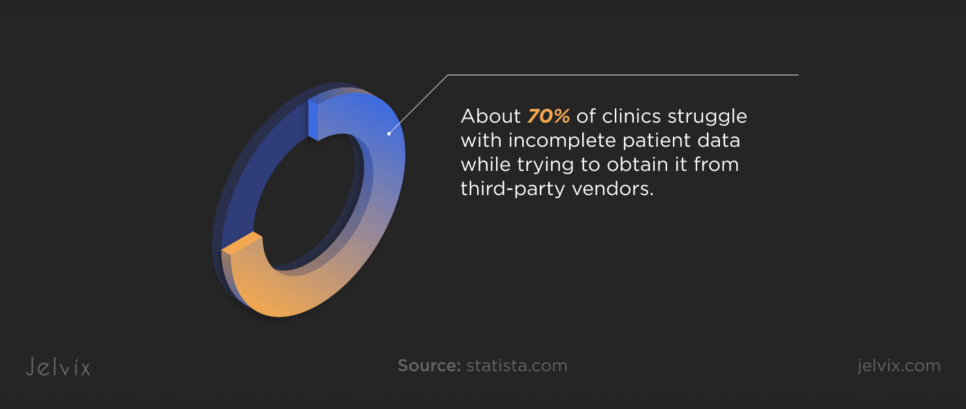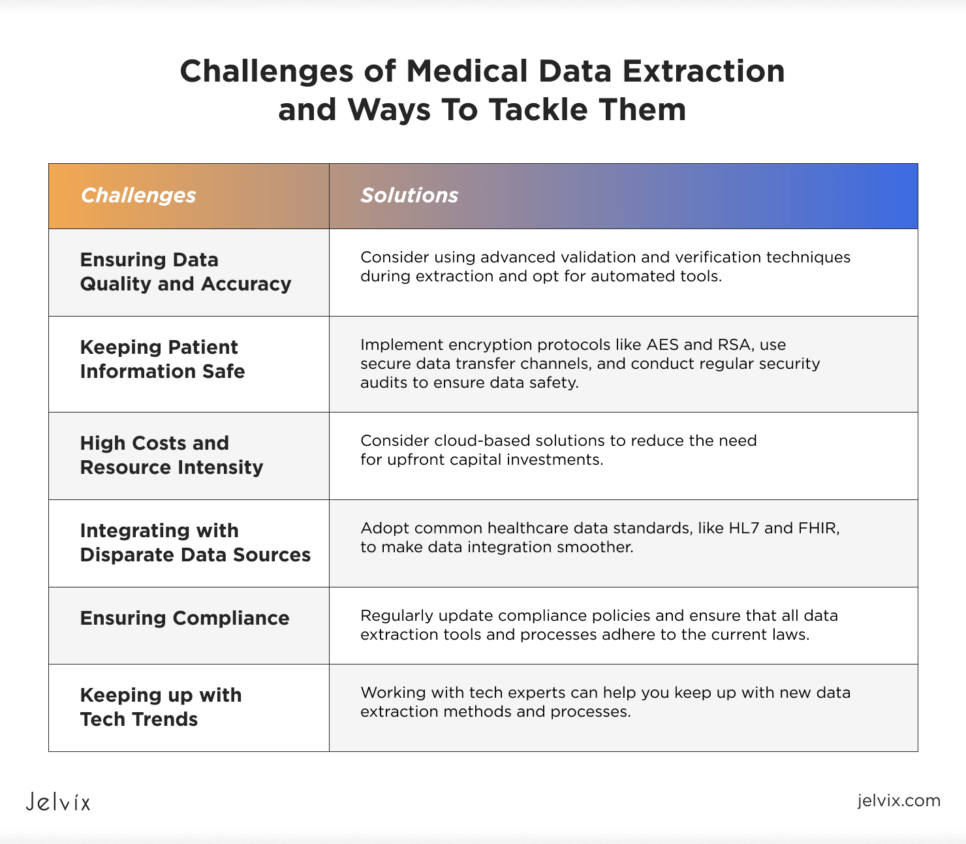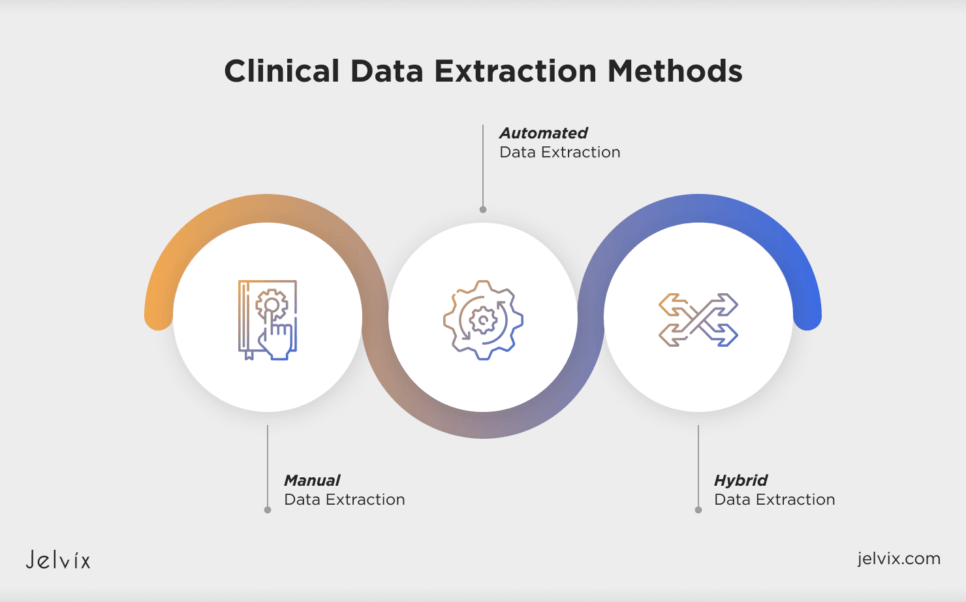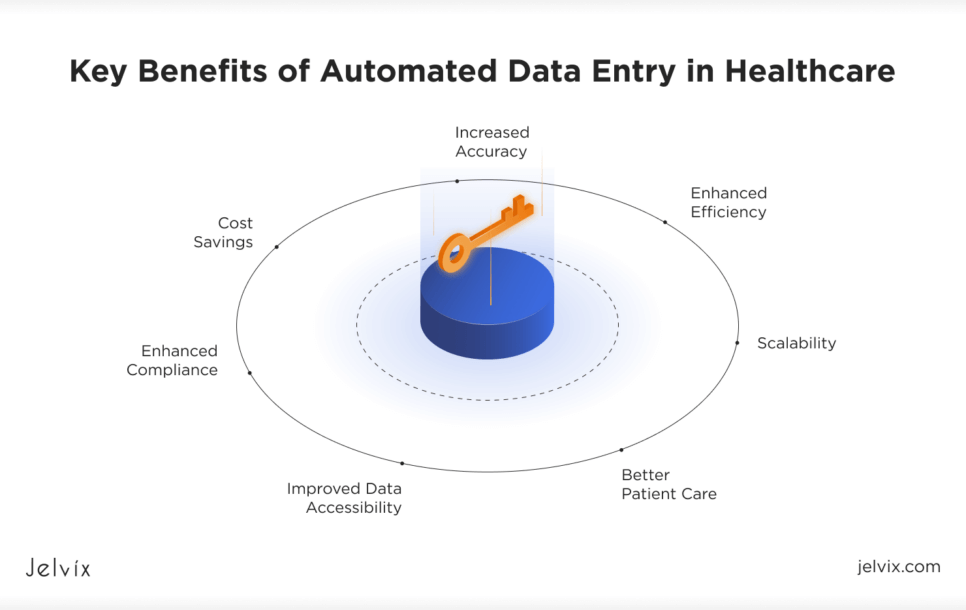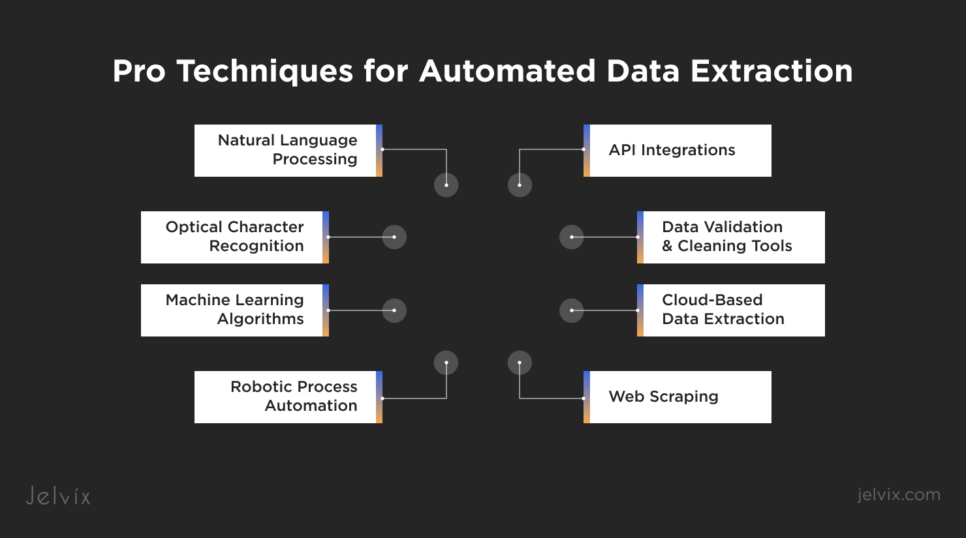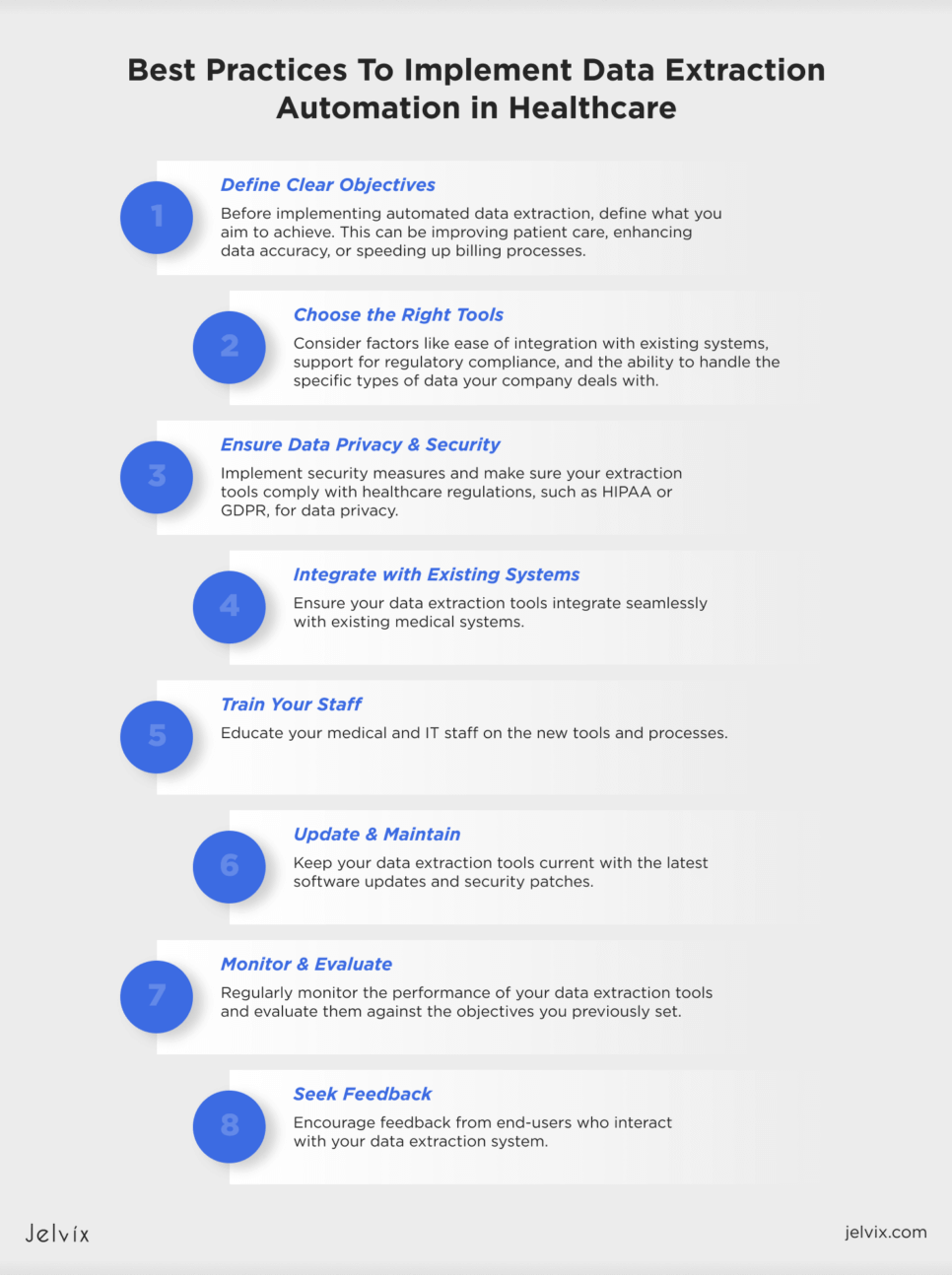As the number of healthcare data increases, medical companies experience difficulties in extracting and managing it. In 2022, about 70% of clinics struggled with incomplete patient data while trying to obtain it from third-party vendors.
This data quality issue made healthcare executives search for better ways to extract patient info, which, finally, led to a logical solution — automation.
If you aim to use high-quality and error-free medical data to treat patients effectively and optimize processes across your clinic, read this article. You’ll find out how to automate data extraction, what challenges to expect during this process, and what techniques to use for the best results.
How Digital Revolution in Healthcare Influenced Medical Data
Digital transformation in healthcare started long ago, and one of the most significant events took place in 2009. The U.S. government issued the Health Information Technology for Economic and Clinical Health (HITECH) Act that boosted the transition from paper-based records to EHRs. This vast EHR implementation impacted how modern hospitals extract, store, and manage healthcare data.
Medical information that was once captured in handwritten notes is now digitally recorded, making it more structured, easier to access, and far more extensive. What’s more, data has become more regulated with data protection laws like HIPAA and GDPR.
However, digitalization presented new challenges in healthcare, such as huge amounts of new data and problems with its quality. It means that medical companies will eventually need to adopt innovative tools to reduce the number of medical errors and prevent fatal care outcomes. Cleaning up the mess in data extraction can be a good start for most clinics.
What Is Data Extraction in Healthcare?
Healthcare data extraction is the process of retrieving data from various sources like EHRs, billing systems, and clinical databases. The main goal here is to use the obtained data to aid healthcare pros, researchers, and policymakers in decision-making, medical research, patient care, and administrative operations.
Data extraction in healthcare often uses advanced tech like natural language processing to interpret free text fields in EHRs and machine learning algorithms to identify and extract relevant patterns and trends from large datasets.
The extracted data must be error-free, reliable, and timely. That’s why most clinics go for automating the data extraction process.
Challenges of Medical Data Extraction and Ways To Tackle Them
Quality medical data allows physicians to understand how to treat patients better. That’s why its extraction must be highly accurate. However, the process often imposes challenges like problems with data security and integration. Consider addressing these issues to enhance patient care and inform your decisions.
Ensuring Data Quality and Accuracy
Gartner reports that medical companies lose about $12.9 million yearly because of poor data quality. What’s more, wrong data can lead to fatal mistakes in how patients are treated. Consider using advanced validation and verification techniques during extraction. Also, opt for automated tools and machine learning algorithms to identify and correct errors or inconsistencies in your medical data.
Keeping Patient Information Safe
Medical data contains sensitive patient information, so keeping it private is non-negotiable. Implement encryption protocols like AES and RSA, use secure data transfer channels, and conduct regular security audits to ensure data safety.
High Costs and Resource Intensity
Setting up new technology to handle data can be expensive and takes a lot of resources. This can be especially problematic for smaller facilities. Consider cloud-based solutions to reduce the need for upfront capital investments. These services can provide a cost-effective, scalable, and flexible alternative to on-premise solutions.
Integrating with Disparate Data Sources
Hospitals get data from different sources, and not all of it comes in the same format. This can make it hard to put all the data together. Think about employing middleware solutions to translate and standardize data from diverse sources. Adopt common healthcare data standards, like HL7 and FHIR, to make data integration smoother.
Ensuring Compliance
Healthcare is a heavily regulated industry, and staying compliant with ongoing regulatory changes can be difficult. Ensure that your data extraction methods comply with regulations like HIPAA in the U.S. and GDPR in the EU. Regularly update compliance policies and ensure that all data extraction tools and processes adhere to the current laws.
Keeping up with Tech Trends
Technology changes fast, and keeping up can be hard, especially for smaller clinics. To stay flexible, adopt a strategy that includes regular updates for extraction tools. Working with tech experts can help you keep up with new data extraction methods and processes.
Clinical Data Extraction Methods: Manual vs Automated vs Hybrid
There are multiple ways that allow you to extract healthcare data for further analysis. These include manual medical data entry, where accuracy depends heavily on human input, and fully automated systems that use sophisticated algorithms to quickly process data and reduce the potential for human errors.
Manual Data Extraction
This is the traditional way of collecting data where healthcare professionals or data entry operators input or copy data from one source to another manually. While this method was popular for a long time, it is considered time-consuming and prone to errors now. Yet, sometimes, it can be useful for medical records that require human interpretation.
Pros:
- Highly customizable: allows for human judgment in interpreting complex medical data that automated systems can misunderstand;
- Flexibility: can be adapted on the go to handle unexpected data formats or unstructured data.
Cons:
- Error-prone: relies heavily on human input, which can lead to inconsistencies and errors;
- Time-consuming: is slower and less efficient for handling large volumes of data.
Automated Data Extraction
Automated data extraction uses digital tools and algorithms to pull data from different sources automatically. This method is faster and more accurate than manual extraction. It can handle large volumes of data quickly, reducing the workload on staff and minimizing the likelihood of human errors. Automated data extraction often uses optical character recognition (OCR) and natural language processing (NLP) to interpret and digitize data.
Pros:
- Speed and efficiency: allows for rapid processing of large amounts of data;
- Accuracy: reduces human errors, providing more consistent data extraction.
Cons:
- High initial cost: can be expensive to set because requires technology and training;
- Less flexible: struggles with data that are not standardized or highly variable.
Hybrid Data Extraction
Hybrid data extraction combines manual and automated methods. It can be useful in situations where automated tools can’t completely replace human oversight because of the data complexity. For example, an automated system can extract most data from medical records, but the most sensitive parts of data might require human verification.
Pros:
- Best of both worlds: combines the accuracy of automated systems with the adaptability of human oversight;
- Versatility: useful in complex scenarios where automated systems can preprocess data, but the final validation requires the human touch.
Cons:
- Complex to implement: managing both manual and automated systems can complicate workflows;
- Costly and resource-intensive: might increase operational costs and require more training for staff.
Each of these methods has its advantages. Consider choosing the best one depending on the size of your healthcare facility, the nature of the data, and the needed data accuracy. However, if you need to extract huge amounts of data across an enterprise, the automated method might be the best option for you.
Key Benefits of Automated Data Entry in Healthcare
Automated data entry is important in healthcare for numerous reasons. From automating routine tasks to reducing operational costs, automation goes far ahead of manual data entry processes, leaving behind human errors.
Increased Accuracy
Automated systems help reduce human errors that often happen during manual data entry. This can lead to higher data accuracy, which is important for patient diagnosis and treatment planning. For instance, an automated system can ensure that all patient identifiers are entered correctly, preventing medication errors or misdiagnoses.
Enhanced Efficiency
Automation speeds up the data entry process, allowing doctors to handle patient information quickly. For example, emergency rooms can use automated systems to enter patient information on the go, which can support urgent care where every second counts.
Cost Savings
Automating data entry and processing reduces the need for manual labor, lowering operational costs. This minimizes the need for extensive staff hours for entering data and allows reallocating these resources to more critical areas.
Improved Data Accessibility
Once data is digitized and stored electronically, it becomes easier for medical staff to access and share patient information when and where needed. This is particularly beneficial in multi-facility practices where specialists in different locations may need to access patient info simultaneously.
Enhanced Compliance
Automated systems are usually designed to comply with healthcare regulations and standards like HIPAA. They can automatically update to include changes in regulations. This ensures that all data handling is up-to-date, offering better privacy to sensitive patient data.
Better Patient Care
Quick and accurate data processing allows healthcare pros to make faster and more informed decisions that make healthcare delivery better and increase patient retention. For instance, with real-time data updates, a physician can quickly assess a patient’s historical health data and current condition, providing timely help in critical care situations.
Scalability
Automated data entry systems are scalable. It means healthcare organizations can easily expand and handle larger volumes of data without an increase in medical errors and care delays. This scalability is especially important for companies that plan to scale up in the near future.
Pro Techniques for Automated Data Extraction
Automated data extraction in healthcare involves several techniques that help make handling patient information more efficient and accurate. These advanced methods help clinics provide better care for patients and work with a smoother-running healthcare system.
Natural Language Processing
NLP helps computers comprehend human language from doctors’ notes. It can automatically pull out important information like diagnosis codes, which helps avoid mistakes and speeds up billing processes. Tools like OpenAI API and IBM Watson can help analyze unstructured text data from clinical notes. Or, you can use Amazon Comprehend if your medical system operates in the AWS infrastructure.
Optical Character Recognition
OCR technology turns written documents like scans of medical records into text that computers can read. This is great for turning old paper records into digital ones, making it easier to search and use this information. You can use Python libs like Tesseract OCR and OpenCV Amazon to develop a custom data extraction solution. Or, you can opt for services like Textract and Amazon Rekognition if you prefer to use AWS infrastructure.
Machine Learning Algorithms
Machine learning models are trained on lots of data to find patterns and make predictions. They can identify important data points across large datasets, such as predicting health risks based on historical health data. Consider tools like Pandas, NumPy, and scikit-learn for advanced data analytics or TensorFlow and PyTorch to work with neural networks. If you opt for an AWS environment, Amazon SageMaker and AWS Deep Learning AMI may be good options for you.
Robotic Process Automation
RPA uses software bots to do repetitive tasks that people used to do. This can include entering data into systems, moving it between different systems, and updating medical records, which saves a lot of time for staff. For instance, you can use RPA platforms like UiPath, Blue Prism, and AWS RoboMaker to automate data entry tasks.
API Integrations
APIs let different computer programs talk to each other smoothly. This means data from health apps or RPM devices can automatically go into patient records without the need to deliver it manually.
Data Validation and Cleaning Tools
Automated tools for data validation and cleaning help ensure the data is correct and helpful. They fix common mistakes, verify data against pre-set rules, and remove duplicates, resulting in better-quality data. For custom solutions, it’s recommended to use Data Ladder, Talend, Pandas, NumPy, or Dora. Or you can opt for AWS services like AWS Glue and Amazon EMR.
Cloud-Based Data Extraction
Cloud platforms offer scalable and flexible environments for storing and processing large amounts of health data. Tools like AWS Glue and Google Cloud Dataflow provide powerful computational resources on demand that can be used to extract and analyze data efficiently, often reducing costs and improving accessibility.
Web Scraping
Web scraping tools use bots to automatically extract data from websites. In healthcare, this technique can be used to gather medical information and research from various online sources, enriching databases with the latest findings, drug information, and clinical guidelines. You can use Beautiful Soup and Scrapy to extract data from HTML or choose Octoparse and ParseHub if you need tools with a user-friendly UI.
Find out how to implement real-time data entry tech seamlessly to enhance patient care, improve data accuracy, and support clinical decision-making.
8 Best Practices To Implement Data Extraction Automation in Healthcare
Implementing automated data extraction in healthcare requires a well-thought-out approach to ensure accuracy, compliance, and efficiency. The Jelvix team recommends that you follow the proven best practices listed below for painless data extraction.
1. Define Clear Objectives
Before implementing automated data extraction, define what you aim to achieve. This can be improving patient care, enhancing data accuracy, or speeding up billing processes. Whatever your goal is, seeing clearly will help direct your efforts and measure success.
2. Choose the Right Tools
Select extraction tools that best fit your clinic’s needs. Consider factors like ease of integration with existing systems, support for regulatory compliance, and the ability to handle the specific types of data your company deals with.
3. Ensure Data Privacy and Security
As you already know, data extracted from medical records includes sensitive patient information. Implement security measures, such as encryption, role-based access controls, and secure data access protocols, to protect data from breaches. Also, make sure your extraction tools comply with healthcare regulations, such as HIPAA or GDPR, for data privacy.
4. Integrate with Existing Systems
Ensure your data extraction tools integrate seamlessly with existing medical systems. You need this seamless integration to maintain data integrity and ensure that it is used accurately across your clinic.
5. Train Your Staff
Educate your medical and IT staff on the new tools and processes. Training will help them understand how to operate effectively. A well-performed training can lead to higher adoption rates and more effective use of the new tech.
6. Update and Maintain
Keep your data extraction tools current with the latest software updates and security patches. Regular maintenance ensures that they continue to function efficiently and securely over time.
7. Monitor and Evaluate
Regularly monitor the performance of your data extraction tools and evaluate them against the objectives you previously set. Use the insights to tweak the process and ensure continuous optimization to tackle new challenges.
8. Seek Feedback
Encourage feedback from end-users who interact with your data extraction system. Their insights can provide valuable information on issues and highlight areas for improvement. Iteratively refine the system based on this feedback to align it with user needs and operational demands.
How Jelvix Can Assist in Automating Data Extraction for Your Clinic
If you want to prevent costly mistakes in medical data, implementing data extraction tools can be a good idea for you. Depending on the size of your medical entity, you can opt for automated data extraction that will free your staff from manual data entry and processing.
At Jelvix, we understand the importance of maintaining the high quality of data in healthcare. That’s why we offer solutions for painless data extraction and management. Depending on your needs, we can build a custom solution that will automatically extract the needed data or integrate the one you already have. Reach out to our experts, and they’ll help you decide on your next steps.
Looking for a technology partner?
Enhance your development capabilities with our dedicated team of professionals.


